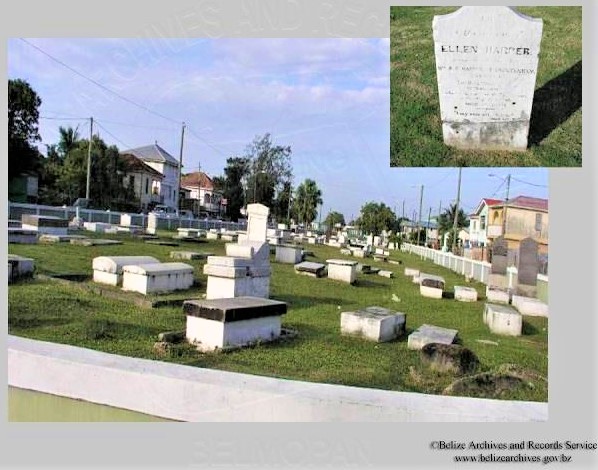~~~~~~~~~
During the 1880's there were listed no less than five public cemeteries in use in Belize City. As early as1787 a plot of land was given to the Government by one
Mr. James Yarborough (an American Magistrate living in Belize from South Carolina) on the condition that it be used as a burial grounds This handing over was formally done at a public meetings when, the entire management and control of the plot were placed in the hands of cemetery trustees. The ground itself was consecrated by the Bishop of Jamaica in 1826.
Remaining in use up until 1877, the Old Yarborough Cemetery, as it was known, was replaced by the New Yarborough Cemetery. The Old Cemetery was almost full at this times, and the New Cemetery was opened just a bit South of it. By the end of 1881 the New Cemetery had to be abandoned due to the low level of the land.
The vaults, which involved burial above-ground were erected and opened in 1882 in the area known as Queen Charlotte Town (once called Coolie Town or Calcutta as the area was the home of Belize City’s East Indian population until the destruction of the 1931 hurricane.) Apart from being unpopular in the settlement, the Vaults became full in 1886. A new burial site constructed in 1885 and name Lord's Ridge Cemetery was opened on a pine ridge on the western edge of Belize City.
Although Lord's Ridge was the principal cemetery, burial was still possible in the Yarborough cemeteries providing that exclusive rights of interment had been secured prior to there being closed.
A Cholera Cemetery situated on Faber's Road, was set aside for use by persons dying from infectious decease such as cholera and yellow fever.
An attempt at having denominational cemeteries did not meet with much success.
In 1840 two cemeteries were set apart for this purpose, one for the Baptists at Freetown and the other for the Methodists just west of the Vaults. They soon became unused and Lord's Ridge became the burial site for all denomination.
Burials used to take place at St. George's Caye during the period when it was the capital of the settlement.
1993 what left of the Yabra Cemetery, less than 50 graves are still there.
Yarborough Cemetery
Named after the magistrate who owned the land in 1781, Yarborough Cemetery in Belize City was a burial ground for Belizean “notables.”
Located a few short blocks west of St. John’s Cathedral, after 1870, Yarborough Cemetery was also used to bury “ordinary folks” including many Belizeans who had volunteered and died in Mesopotamia during World War II. By 1890 the cemetery had run out of burial plots and was abandoned. A new cemetery was established at the entrance to what is today the Western Highway.
To restore dignity to the interred, in 1999 the cemetery was renovated with the addition of a perimeter fence, landscaping and stabilization of all remaining headstones and a marble memorial wall highlighting the names and contributions of those buried there.
Visitor Experience
Open Days: Monday-Sunday
Open Hours: Open all day
The cemetery is opened to the public seven days of week. There is no security at the location, so its advisable to go with a local tour guide or during daylight hours.
A wooden 4ft. height fence was place around this end of the burial ground.
A connection to a very important part of the Belizean history, where many of the Baymen, Settlers and Slaves were buried, and vanished.s just about
Yaborough Cemetery



